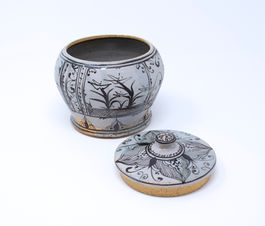Ceramics and Sound
Handelier. 7' x 7' x 7'. Earthenware and porcelain, 2010. Composed mostly of pulled handles, this piece was from 2011 exhibition for the 2009 Fogelberg Fellows in the Emily Galusha Gallery at Northern Clay Center. Tiny candelabra sat on the stages of each arm with porcelain holders. Images by Peter Lee.


Various Earthenware Objects. Generally 20" x 15" x 15". Cone 3 earthenware, slips and glazes, 2013. These were experiments in extreme objects that attempted to maintain some semblance of utility. Hand-built with thrown parts and slips, these were largely color and glaze tests.





Baskets and Tessellating Cups. Various sizes. Earthenware and porcelain. 2015. There is a departure from color while still creating objects that maintained some utility. Still playing with ideas about geometry and form while learning to assemble the parts.



Bronze Jars. Generally 20" x 14" x 16". Cone 6 stoneware, 2009. Some work from my Bachelor's thesis. These objects of containment were exploring the ideas about how to use an object before you interact with them. Connected or multiple lids or hinges or combinations of the aforementioned would challenge users to unpack the storage objects.



Spouted Plinths. 14" x 8" x 10". Cone 6 stoneware and bronze glaze. 2009. Working with stages, pottery pieces could be placed on the fields as formal actors who could allude to use.


Other objects and Candelabra. Various sizes. Stoneware and porcelain, 2009. These are a play on the idea of animation frozen by the kiln (more experiments).



Luciferins. Various sizes, cups are 3" in diameter. Cone 6 stoneware with pigmented alumina slip, 2008. "Luciferins (from the Latin lucifer, "light-bringer") is a generic term for the light-emitting compound found in organisms that generate bioluminescence. Luciferins typically undergo an enzyme-catalysed oxidation and the resulting excited state intermediate emits light upon decaying to its ground state", Wikipedia, 2020. These candelabra were developed from mapping out Bohr model molecules of luciferin compounds and adenosine trihosphate in plankton that were responsible for their bioluminescence. Each cup represented an electron in that compound group and was made to hold a pedestal candle.







Various Candelabra. Various sizes, cups are 3" in diameter. Cone 10 stoneware, 2008.

























